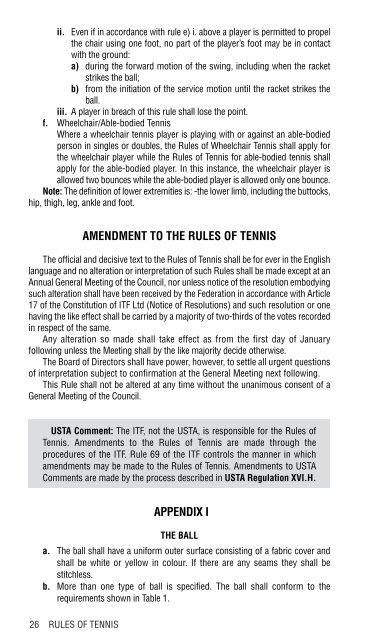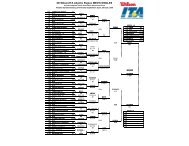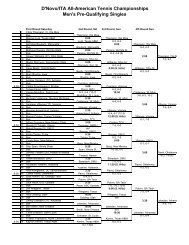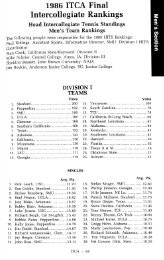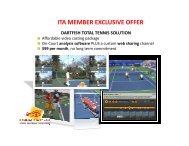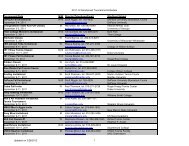- Page 1 and 2: 2009 EDITION FRIEND AT COURT TENNIS
- Page 3 and 4: FRIEND AT COURT THE USTA HANDBOOK o
- Page 5 and 6: Foreword The most apparent change i
- Page 7 and 8: USTA Regulations [p. 53] New FAC Co
- Page 9 and 10: [p. 164] Table 18 Match Formats for
- Page 11 and 12: Contents Foreword..................
- Page 13 and 14: A. Junior National Tournament Regul
- Page 15 and 16: CONTENTS OF THE FIGURES Figures 1 P
- Page 17 and 18: FOREWORD The International Tennis F
- Page 19 and 20: i. After an agreed odd number of ga
- Page 21 and 22: Additional approved alternative sco
- Page 23 and 24: USTA Comment 9.1: When should the t
- Page 25 and 26: USTA Comment 15.1: Do the partners
- Page 27 and 28: USTA Comment 18.6: When may the rec
- Page 29 and 30: USTA Comment 23.1: What happens whe
- Page 31 and 32: USTA Comment 24.4: What happens if
- Page 33 and 34: lob in doubles and loudly shouts
- Page 35 and 36: One is in the case of a doubles mat
- Page 37 and 38: seconds allowed when the players ch
- Page 39: USTA Comment 30.2: Is coaching perm
- Page 43 and 44: 01/02 (ITF Court Pace Rating) as de
- Page 45 and 46: USTA Comment IV.1: USTA Regulation
- Page 47 and 48: adverse court conditions. When play
- Page 49 and 50: an unreasonable request or that it
- Page 51 and 52: 7. PROPOSED RULINGS BY THE RULING B
- Page 53 and 54: 13. APPOINTMENT AND COMPOSITION OF
- Page 55 and 56: 78'0" 23.77m) PLAN OF THE COURT Fig
- Page 57 and 58: of at A and B, and by then using le
- Page 59 and 60: PART 2—THE CODE THE PLAYERS’ GU
- Page 61 and 62: 11. Requesting opponent’s help. W
- Page 63 and 64: 30. Delays during service. When the
- Page 65 and 66: MISCELLANEOUS 44. Clothing and equi
- Page 67 and 68: FAC Comment I.A-3: The term “Dist
- Page 69 and 70: USTA Reg. I.C.4. I.H.3. I.H.4. IV.C
- Page 71 and 72: a. Presence of Referee or Deputy Re
- Page 73 and 74: election on the entry form. See App
- Page 75 and 76: ii. NTRP division if the player’s
- Page 77 and 78: Tournaments starting in 1/10: 18s b
- Page 79 and 80: • Players affected by the review
- Page 81 and 82: Example of an Entry Form Nebraska J
- Page 83 and 84: It may also accept players of estab
- Page 85 and 86: II. DRAW REGULATIONS A. Seeding Whi
- Page 87 and 88: • Player in the draw was not seed
- Page 89 and 90: A B C D E F G H B D F H b. Position
- Page 91 and 92:
After all seeds have received Byes,
- Page 93 and 94:
. To lines opposite seeds if one in
- Page 95 and 96:
second-round play third-round quali
- Page 97 and 98:
top half of the first and second qu
- Page 99 and 100:
Modified Curtis Feed-In Championshi
- Page 101 and 102:
FAC Comment II.B-7: Adams has the b
- Page 103 and 104:
the final round, then the final rou
- Page 105 and 106:
the correct position. The ninth see
- Page 107 and 108:
Fig. 8 Players Omitted from Draw US
- Page 109 and 110:
3. Late entries and substitutions i
- Page 111 and 112:
the official draw sheet. Before beg
- Page 113 and 114:
TABLE 7 Scheduling Guidelines for A
- Page 115 and 116:
III. CONDUCTING THE TOURNAMENT A. T
- Page 117 and 118:
A. Definitions Actions Initiated by
- Page 119 and 120:
Walkovers Defaults Retirements Othe
- Page 121 and 122:
TABLE 9 Minimum Rest Between Matche
- Page 123 and 124:
2. Player may not leave Tournament
- Page 125 and 126:
then aggravates that injury during
- Page 127 and 128:
Who may treat Treatment during 90-s
- Page 129 and 130:
If there is no practical way to fin
- Page 131 and 132:
in USTA tournaments constitutes con
- Page 133 and 134:
authorized entry into another tourn
- Page 135 and 136:
player penalized for lateness also
- Page 137 and 138:
Time Violations • Delay between p
- Page 139 and 140:
Racket Abuse Ball Abuse Audible or
- Page 141 and 142:
point penalty for delay and told th
- Page 143 and 144:
FAC Comment IV.D-15: What should an
- Page 145 and 146:
V. POST-TOURNAMENT REGULATIONS A. R
- Page 147 and 148:
VI. OFFICIATING REGULATIONS A. Refe
- Page 149 and 150:
or the Chief Umpire replace one or
- Page 151 and 152:
from White Plains, NY, Jerry Baker;
- Page 153 and 154:
points: “Game Smith,” (pause an
- Page 155 and 156:
Example of Scorecard Marking Fig. 9
- Page 157 and 158:
Fig. 11 USTA REGULATIONS VI.C. (Cha
- Page 159 and 160:
FAC Comment VI.C-9: In a match with
- Page 161 and 162:
FAC Comment VI.D-3: It is improper
- Page 163 and 164:
Chair Umpire shall report this to t
- Page 165 and 166:
FAC Comment VI.G-1: An official nee
- Page 167 and 168:
d. ITF tournaments on National Juni
- Page 169 and 170:
TABLE 17 Seeding Criteria for USTA
- Page 171 and 172:
Entry into USTA National Championsh
- Page 173 and 174:
These players shall be listed in th
- Page 175 and 176:
eplace a player who withdraws, is d
- Page 177 and 178:
The Youth Competition and Training
- Page 179 and 180:
iii. Player may play in only one ag
- Page 181 and 182:
conducted in an unobtrusive manner
- Page 183 and 184:
promptly inform the Director of Jun
- Page 185 and 186:
shall sanction at least one Categor
- Page 187 and 188:
FAC Comment VII.B-6: USTA Regulatio
- Page 189 and 190:
2. National Seeding Lists. At least
- Page 191 and 192:
main draw doubles match. For exampl
- Page 193 and 194:
IX. SANCTIONING REGULATIONS A. Gene
- Page 195 and 196:
although for clarity, the word “O
- Page 197 and 198:
c. Submission to appropriate compet
- Page 199 and 200:
Championships, as set forth in USTA
- Page 201 and 202:
XI. USTA JR. TEAM TENNIS A. Descrip
- Page 203 and 204:
36' ➝ ➝ ➝ ➝ 13'6' 18' ➝
- Page 205 and 206:
XII. REGULATIONS GOVERNING AMATEUR
- Page 207 and 208:
5. Travel. Travel expenses are allo
- Page 209 and 210:
event is $250. Thus, if an amateur
- Page 211 and 212:
professional activities is less tha
- Page 213 and 214:
• a Default that occurs before th
- Page 215 and 216:
National Ranking Tournaments in whi
- Page 217 and 218:
Ranking Period for all players shal
- Page 219 and 220:
FAC Comment XIV.D-1: The Profession
- Page 221 and 222:
Adult & Senior Family • Men’s d
- Page 223 and 224:
Singles Doubles • Junior Open/A (
- Page 225 and 226:
• Aliens with Refugee Status. Ali
- Page 227 and 228:
c. Final rankings. These are the si
- Page 229 and 230:
XV. REGULATIONS FOR CERTIFICATION O
- Page 231 and 232:
6. Number of tournaments. Every yea
- Page 233 and 234:
• The remaining matches must be i
- Page 235 and 236:
K. Records 1. The USTA Officials Co
- Page 237 and 238:
Committee, to each Sectional Associ
- Page 239 and 240:
PART 4—USTA EMERGENCY CARE GUIDEL
- Page 241 and 242:
The symptoms and signs of heat illn
- Page 243 and 244:
This Heat Index Chart provides gene
- Page 245 and 246:
assigned to these tournaments to do
- Page 247 and 248:
academies. Upon request, the USTA w
- Page 249 and 250:
Jr. McGovern Award Recipients With
- Page 251 and 252:
PART 7—INTERCOLLEGIATE TENNIS ASS
- Page 253 and 254:
FAC EDITORS’ NOTE USTA officials
- Page 255 and 256:
problem. A player who does shall be
- Page 257 and 258:
D. ITA Scoring Systems 1. NCAA Divi
- Page 259 and 260:
event) determine that extraordinary
- Page 261 and 262:
trainer has a maximum of five minut
- Page 263 and 264:
Any deviation from this standard sh
- Page 265 and 266:
4. Matches shall be played to compl
- Page 267 and 268:
• a high of at least 50°; or •
- Page 269 and 270:
impossible. This must be confirmed
- Page 271 and 272:
the singles match is not part of th
- Page 273 and 274:
position. The No. 1 singles match c
- Page 275 and 276:
a. A tournament must be sanctioned
- Page 277 and 278:
INTERCOLLEGIATE TENNIS ASSOCIATION
- Page 279 and 280:
Block Seeding. Block Seeding refers
- Page 281 and 282:
Endorsement. Endorsement refers to
- Page 283 and 284:
National Ranking Tournaments. These
- Page 285 and 286:
Ranking. Ranking is a static concep
- Page 287 and 288:
Tournament. Tournament refers to mo
- Page 289 and 290:
PART 9—INDEX INDEX TO THE RULES O
- Page 291 and 292:
Ball Change Correcting error.......
- Page 293 and 294:
Certification .....................
- Page 295 and 296:
Delays Between Serves.........R 23,
- Page 297 and 298:
Service after......................
- Page 299 and 300:
Hindrance by player ...............
- Page 301 and 302:
Numeric scoring ...................
- Page 303 and 304:
Held in hands .....................
- Page 305 and 306:
Bleeding Time-Out .................
- Page 307 and 308:
Score, scoring 10-and-under competi
- Page 309 and 310:
Score .............................
- Page 311 and 312:
Draw sheet submission..............
- Page 313 and 314:
Draw format........................
- Page 315:
FRIEND AT COURT THE USTA HANDBOOK f


